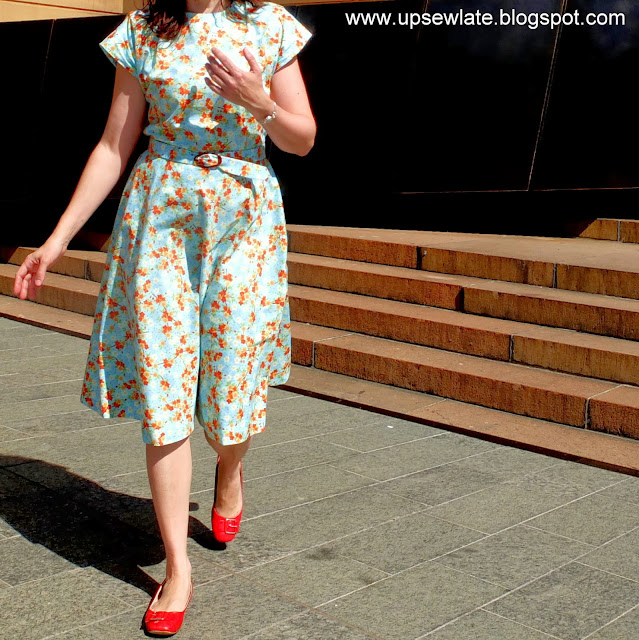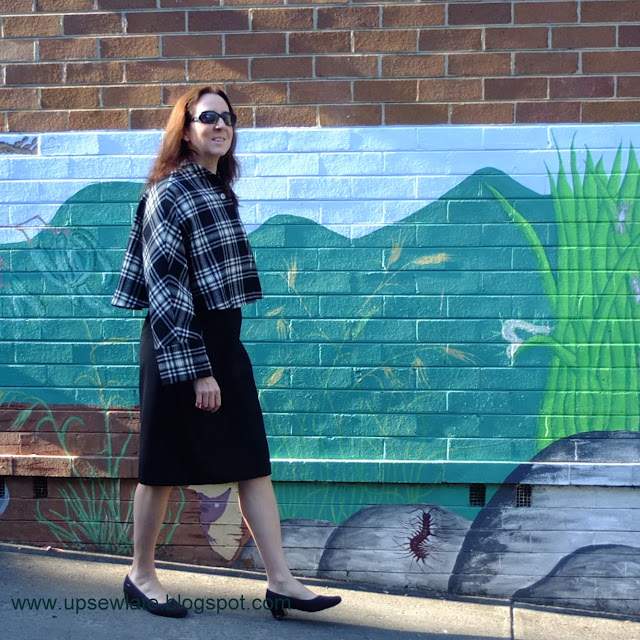
Ta da! Here's my
TMS vintage effort for the month of September - and also my
Fall for Cotton entry (is that a bit cheeky, or super efficient?!).

Not sure if you can see any details - it's quite a plain little dress; a very simple 1940 silhouette courtesy of
Vogue 8811, - but we were having such a hot, bright Spring day that my outside photos were a bit washed out (I've darkened these significantly).
I originally made and blogged about this pattern last year (back
here) as a crunchy, exciting pewter coloured taffeta, but that version only fits when I'm at my thinnest, which is not necessarily when I want to wear it. This version differs in more than fabric choice: I graded it up in the waist (necessity), left the neckline pretty close to the original pattern instead of scooping it out and adding a collar, and in the spirit of proper vintage sewing, made those shoulder pads myself from layers of cotton wadding with a darted fabric cover.
Can you guess where we took these photos? And by "we" I mean my kids... Well obviously it's a gallery, but this is the
Art Gallery of NSW. Culture - and so much of it for free!

Naturally I wouldn't have had this smug expression on my face if I'd realised one shoulder pad was trying to break free... what a goose!
Ignoring the wayward shoulder pad, you may be able to see that the shoulder pads are pretty much just a reflection of my natural shoulder line. I suspect now that they're supposed to give a slightly extended shoulder line - but I really don't know what's right for the 1940s.
I know I'm not showing you photos of all these details, but my back button is vintage, the press stud it's hiding is vintage, and the belt buckle is vintage (probably a
different vintage, but it was the best match I had to hand). I have to say this is probably the worst belt I've ever made - I should've used something heavier than interfacing, I don't know what I was thinking. Maybe I'll make a new belt with some buckram inside it... And I don't know that this is a vintage feature or if I was just half asleep, but I didn't see instructions for any interfacing to be used apart from in the belt so that's the only place I used it - and of course in the belt it's completely insufficient.

The invisible zip which you really can't see in these photos IS pretty invisible and is modern, and the fabric is modern - Japanese quilting cotton from Lincraft, bought in a panic when I was trying to get this project done early. The fabric is (of course) cotton, and having pored over a bunch of 40s dresses on the internet and in books, I thought the floral pattern looked suitable for the period. I've never sewn for myself with quilting cotton before, and I was worried that it would be too heavy or have poor drape. This particular cotton is lightweight and drapes well after a wash, but I don't know if it's going to have the longevity of a fashion fabric. I hope it does, because the dress feels lovely and breezy on a hot day, while still looking kind of smart.

As you can probably tell, the weather was really hot - Aussie mid-Summer hot. Heaven help us if Summer is hotter than Spring this year; the bush fires have already started!
So why did it take so long for me to make a simple cotton dress?
Well, the above dress is not the one I started out making. I was originally trying to make this pattern:
I had the pattern in the right bust size, and I graded up for waist and hips. Then I made my muslin, and WOW the fit! It was absolutely appalling! There were a good 2 inches of what
seemed like excess fabric in the front upper bodice, and another 2 in the back! Now I know I have narrow shoulders and a small bust, but surely the women of the 1940s didn't have such broad shoulders...
Without really knowing what 'good fit' was in the 1940s, I then spent a lot of time thinking instead of sewing. It was possible that the style of the time was for a lot of excess fabric around the shoulders and bust (hmmm maybe a bit of ease was considered stylish... but probably not this much), but another real possibility was that McCalls back then were known for their out-of-control vanity sizing (hey, maybe it was just as much of a hot topic then as now).
I pinned out the excess on my dress dummy, but then I got cold feet.
I've had this muslin on my dress dummy now for a few weeks, and I've decided that regardless of how authentic to the 1940s this fit is, I like it. I want to make it like this (but regular length) in a crepe or silk satin; something really drapey.





























.jpg)





